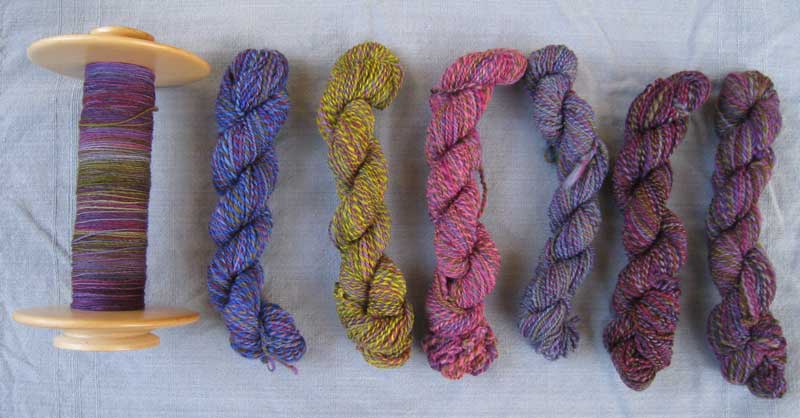One of the retreat sessions that I took was Plying for Color with Deb Menz. It was announced at dinner that Deb assigned homework. A 5 oz bump of hand painted roving needs to be spun into singles for class. Because I went on the HTTM field trip, I didn’t find out my classes until after dinner, around 9PM. My class was at 9AM the very next morning. Yikes!
Most everyone I talked to had a plan. Spin fat. Spin fast. Let someone else do the spinning for you (at the bottom of the post). I took Sheila’s cue and stripped mine down to little strips. But at 10PM, my brain was fried. I went into auto mode and ended up spinning my default yarn — fine, and paid for it by spinning into the wee hours of the morning. I finally gave up around 2 or 2:30 AM because I still had to pack. Due to overbooking at the hotel, I had to give up my wonderful suite with a view of the sunrise for a dinky little room overlooking the kitchen vents the next morning. I finally got to bed around 3AM or so. The 6AM alarm came way too soon.
I finished spinning the rest of it after breakfast and room changes, but before the class started.
First, I should tell you that my bump in the roving gave the impression of mostly purples with some splotches of khaki green. (I didn’t have the wherewithal to take a photo of the bump.) As you can see, it spun up quite differently. Reds and blues came out that my tired eyes didn’t pick out the night before. Perhaps it was just the bad hotel night lighting. Deb then gave us some exercises with 1/3 oz bits of roving she had laid out on the tables.
- Choose an analogous color: I chose royal blues
- Choose opposite of warm/cool: I chose yellow (warm)
- Choose a color from your single: Deb helped me pick a brash hot pink
- Choose a value scale contrast: I liked how the blue (#1) turned out, so I tried a different value scale; a lighter, less saturated blue
- Random: Deb started tossing totally random bits of roving at us from an armful she picked up. Mine had black and reds in it.
- Last exercise was to ply it against itself.
The photo above shows the singles and the exercises listed from left to right. What did I like best? Would you believe the totally random colors (#5)? The black really intensified the colors. The least? The yellow and the pink. Too brash for me. The bright colors overwhelmed what attracted me to the roving to start. Most surprising? How muted and washed out the plied against itself was. This is my basic spinning/plying when it comes to painted roving. It’s not bad, but I can see now that I can do so much better.
I think I have some leftover black/red 60s merino roving somewhere. I can finish plying up the remaining singles with it. Before I do that, I want to knit a swatch with these to make sure that they are as good in fabric as they are in yarn. As Deb says, the yarn isn’t the product. It’s only the intermediate step. You have to see it in fabric before you can decide if you like the effect for not.
(And yes, the homework really was necessary. There was much spinning and plying to be done in the 3 hours as it was. If we had to spin the base singles too, we would have never completed the exercises.)

